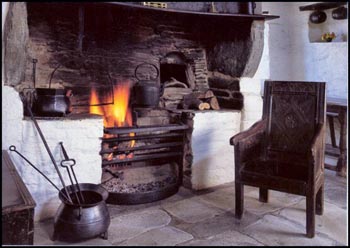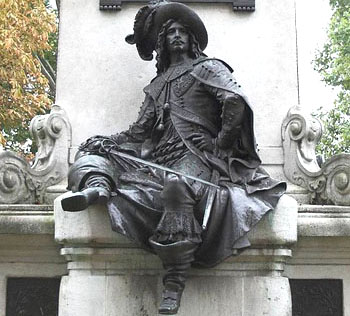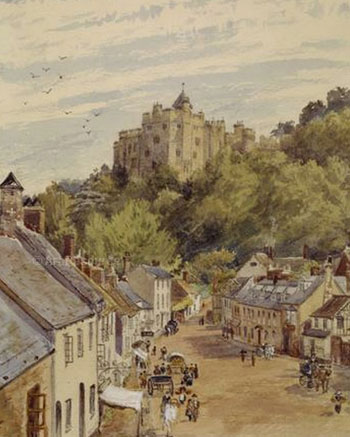 |
Socio-Political Issues
Liberalism, Socialism, Feudalism - VI
The Medieval Family & Subsidiarity
Plinio Corrêa de Oliveira
In medieval society structured around the principle of sudsidiarity, the principal cell, the foundation of society was the family. The family was considered the model for the social order. In France the jurists had a beautiful expression to show the role of the family in the State. They used to say: In medieval society the father is the king of the children, and the king is the father of the fathers. The regime was paternal.

No matter how modest he was, the father had his chair; around him the family would gather in the evening |
In this paternal system, no matter how modest the house, the father had his special chair where he would sit after he had returned home from work, removed his rough shoes and washed up. In front of his chair was a small wooden stool where he rested his feet. On a side table, sat his pipe ready to smoke and some drink placed there by his wife.
As he rested from the fatigues of the day, the children would come to sit around him and inquire about his day. This familiar conversation would continue through dinner, when a nourishing soup and hearty bread would be served. Afterward, the family would pray and go to bed. It was the atmosphere proper to the life of the family, which the father governed completely.
Reminiscent of this medieval climate was the life of the Portuguese-Brazilian families at the time of the Brazilian Colony, where everything gravitated around the father. Some depictions of families of that time made by Debré are quite picturesque. He painted families going out together to public parks and squares on Sundays, walking in a row behind the father. A strong Portuguese type, the father headed the line in his two-horned hat; after him came his wife, and then the children in order of age, followed by the servants, who also joined the family on Sunday holyday excursions and outings. This represents the authority of the pater, the father.
The role of primogeniture
Under the system of primogeniture, the father generally used to leave his patrimony to his eldest son. But this was not conceived in a way that the eldest had everything and the others had nothing.
Let us imagine the case either of a peasant who leaves his house and belongings to his son or a noble who leaves his castle to his firstborn. We will start with the case of the noble since it is simpler.

Through the firstborns the patrimony of the family was kept and improved; above, a noble family tree |
The noble typically had a large family, often with 10 or 15 children. When he died, he would leave his castle and lands of the fief surrounding it to his eldest son. We should not imagine that the other children were obliged to leave the home and start new lives from ground zero with only the eldest enjoying a stable situation. This was not the way things happened.
The eldest son had an obligation to care for his brothers and sisters and arrange – through the network of family relations – a good situation for each one. So, he would assume the role of his father for his brothers and sisters. Sometimes he would not be successful in finding suitable situations for some of them, and these he would invite to live in the castle with their own families. Normally those castles were enormous with numerous extra rooms. The eldest son had the obligation to provide in this way for his siblings.
Many times this duty would extend not only to his brothers and sisters, but also to his less fortunate cousins or other further removed relatives of his father, grandfather or even great-grandfather. So, he used his means and influence to help all these people.
It was not only the young persons starting out in life whom the heir had to assist. There were also the elderly persons of his family who could no longer work. The eldest son had to welcome them on his lands and provide for them to have a dignified life in the castle or on some property of his fief.
The role of adventure

In Paris, the legendary D'Artagnan immortalized in bronze to recall his daring deeds and panache |
Now, since country life can be quite monotonous, it was common for the younger brothers to leave the home and set out in quest of adventure. In French literature we see the cadets, i.e., the youngest sons of noble families who would go to Paris and enlist in the army. There they would try to win for themselves through their bravery and heroism a better situation than what they had in their families.
The personages of Cyrano de Bergerac and the musketeer D’Artagnan, depicted by authors Edmond Rostand and Alexander Dumas, are expressive of the adventures those young nobles would undertake. This gives us an idea of the role of the adventure throughout the Middle Ages.
So, instead of residing passively in the countryside relying on their eldest brother - a
situation that can understandably be considered very boring - these young men would set out in quest of adventure. But even here, we find the guiding principle of subsidiarity. If they failed in their quests or were seriously wounded, they could always return to live in the castle with the eldest brother.
The worker’s life
Something similar took place in the life of the manual worker. Generally speaking, the Middle Ages did not have manual workers like ours today, who have no land of their own. Then, the worker had hereditary rights to a part of the lands he rented and worked, which supplied sufficient goods to provide for himself and his family. When he died, his descendants would have the same right to that same land. This situation repeated that of the castle owner in some ways.

Both the villagers and the nobles were governed by the rules of subsidiarity |
The manual worker was exempt from going to war. He could enter the ranks if he wanted, but he was not obliged to do so. Many times he would enlist with the aim of earning rewards by his brave deeds. Should he distinguish himself heroically in a battle, the lord would award him his own land.
This is how the principle of subsidiarity operated throughout society. The fathers and their firstborns helped the other members of the family.
This explains why the modern principle that calls for equal shares of the inheritance for all the children destroys the principle of subsidiarity in society. With equal distribution of the father’s patrimony, each child makes his own way, doing what he likes with his part. Shortly, the family patrimony is dispersed and no one feels the obligation to help another. Should someone need something, he turns to strangers or the State for assistance. In the medieval system guided by the principle of subsidiarity, however, one would help another as members of the same family.
As history shows us, the exercise of the principle of subsidiarity in the Middle Ages worked well and brought prosperity to families. Karl Marx himself wrote in one of his books that the Middle Ages was the golden age of the worker.
Such was the wise organization that the Catholic spirit gave to the social structure. That structure was based on the principle of subsidiarity.
Continued

Posted May 25, 2012

Related Topics of Interest
 The Principle of Subsidiarity The Principle of Subsidiarity
 Subsidiarity and Feudalism Subsidiarity and Feudalism
 Patriarchs Patriarchs
 Two Basic Aspects of the Medieval Mentality Two Basic Aspects of the Medieval Mentality
 Feudalism and the Modern State Feudalism and the Modern State
 The Three Orders of Medieval Society The Three Orders of Medieval Society
 Proportion between the City and the Man Proportion between the City and the Man
 Medieval Work & Leisure Medieval Work & Leisure
 Respectability in the Medieval Professions Respectability in the Medieval Professions

Related Works of Interest
|
|
Social-Political | Hot Topics | Home | Books | CDs | Search | Contact Us | Donate

© 2002- Tradition in Action, Inc. All Rights
Reserved
|
 |
|